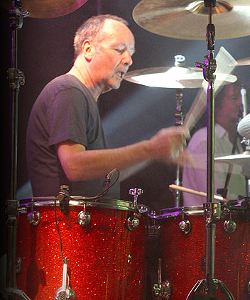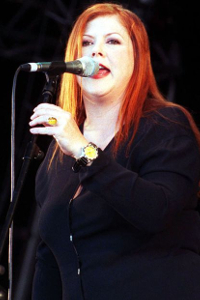 Brian Michael Downey, Irish drummer best known as the drummer and a founding member of the rock band Thin Lizzy, is born in Dublin on January 27, 1951. Along with Phil Lynott, Downey is the only constant member of the hard rock group until their break-up in 1983. Downey also co-writes several Thin Lizzy songs. Allmusic critic Eduardo Rivadavia argues that Downey is “certainly one of the most underrated [rock drummers] of his generation.”
Brian Michael Downey, Irish drummer best known as the drummer and a founding member of the rock band Thin Lizzy, is born in Dublin on January 27, 1951. Along with Phil Lynott, Downey is the only constant member of the hard rock group until their break-up in 1983. Downey also co-writes several Thin Lizzy songs. Allmusic critic Eduardo Rivadavia argues that Downey is “certainly one of the most underrated [rock drummers] of his generation.”
Growing up in Crumlin, Dublin, Downey’s early musical influences come from his father who plays in a local pipe band and loves jazz, and also from his 60’s heroes: The Kinks, The Beatles, and The Rolling Stones. In his youth, Downey meets friend, co-founder, and bass guitarist Phil Lynott, who attends the same school. Before forming Thin Lizzy, Downey has been in numerous school bands, beginning with The Liffey Beats, Mod Con Cave Dwellers, and briefly The Black Eagles (with Lynott). He moves on to performing in a local band, Sugar Shack, and then is persuaded by Lynott to join him in another band, Orphanage. Upon meeting guitarist Eric Bell, the trio form Thin Lizzy. Although the line-up of musicians within the band changes over the years, with the exception of Lynott, for the next thirteen years Downey remains the only other permanent member of the band, as well as drumming on Lynott’s solo albums.
After Lynott’s death in 1986, Downey plays in the tribute Thin Lizzy line-up with John Sykes, Scott Gorham, Darren Wharton, and Marco Mendoza, but has been absent from subsequent Thin Lizzy touring bands. After John Sykes’ departure from the group in 2009, guitarist Scott Gorham creates another line-up of Thin Lizzy. Downey, Mendoza, and Wharton rejoin, along with two new members: Def Leppard guitarist Vivian Campbell and former vocalist from The Almighty, Ricky Warwick. This version of Thin Lizzy starts an extensive world tour in January 2010 and continues to tour until early 2013, with new permanent guitarist Damon Johnson eventually replacing Richard Fortus. Gorham has stated that the band members are considering recording new material, and this project eventually emerges under the Black Star Riders name, with which Downey chooses not to be involved due to the pressures of consistent touring.
Downey is a guest at the unveiling of Lynott’s statue in 2005, and drums for Gary Moore at the tribute concert that follows. Downey also appears on Moore’s 2007 album, Close As You Get, and subsequent tour.


 In 2001, a bench is placed by the southern entrance to London’s
In 2001, a bench is placed by the southern entrance to London’s